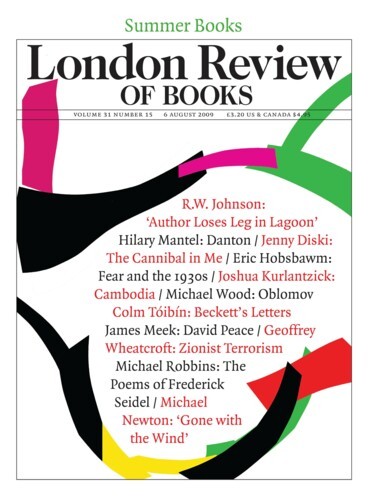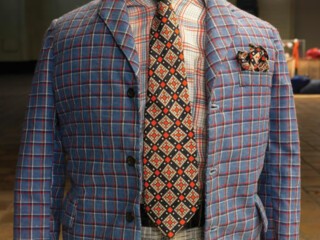A beguiling piece of work by Charles LeDray, Mens Suits (no apostrophe, he insists), can be seen until 20 September at 1 Chiltern Street, W1. The building used to be the local fire station. In its present state it fits the atmosphere created by LeDray’s displays of miniature garments very well. The large, dim garage that housed the fire engines resembles a run-down warehouse (there are plans to turn it into a hotel). Within it three small areas are defined by light from fittings set in sections of suspended ceiling. Each section is only a couple of metres square and is hung a bit above waist height so that you have to bend over to get a look at the lights and acoustic tiles. The ceilings are mirrored below by rectangles of tiled floor. The doll’s house dimensions of the wall-less rooms created by the pools of light that fill these three floor-and-ceiling sandwiches determine the scale of the things set out in them.
There are wheeled racks, loaded with jackets or with empty coathangers; ties, set out on a round table to make a wheel of colour; a tailor’s dummy dressed in jacket, shirt, tie and trousers; tables stacked with shirts; dump bins, anonymous bags, an ironing-board and a stepladder. Full size, these things might be found in any garment district. The bins and racks are the sort you see wheeled from one ‘wholesale only’ showroom to another; in Mens Suits they re-create the back-room sorting space and front-room display spaces of a second-hand clothing store.
Everything is wonderfully made. On a technical level LeDray’s work has the competence of the model tankers and cruise ships you see in the offices of shipping companies, or of the model steam engines made by hobbyists who, like LeDray, spend years on single projects. His tailoring would be a credit to any dolls’ dressmaker, and his thrift shop suggests stories in a way model ships and steam engines don’t and dolls in their houses do. Mens Suits, like the stores it represents, is oppressive in its stuffy abundance. It confirms one’s impression that the more expensive the shop the fewer garments are put on display.
Lots of imagined doll-lives figure in children’s books and their finery has found its way into grown-up fiction. In Our Mutual Friend Jenny Wren, a dolls’ dressmaker, complains of the inconsiderate habits of the fine ladies she sews for: ‘And they take no care of their clothes, and they never keep to the same fashions a month. I work for a doll with three daughters. Bless you, she’s enough to ruin her husband!’ Is Jenny Wren busy? ‘I’m slack just now. I finished a large mourning order the day before yesterday. Doll I work for, lost a canary-bird.’ The men who have discarded the clothes in Mens Suits, and those who will buy them are, like Jenny Wren’s clients, an implied presence. Descriptions of other things LeDray has done tell more about the territory he takes you into. Workworkworkworkwork consisted of 588 tiny objects – books, magazines, shoes, pottery, bedding and so on – that re-created the displays of goods for sale that homeless people place on New York sidewalks. That collection was put out for one day in 1991, set in groups along 45 feet of pavement in Cooper Square.
Generally speaking Brobdingnagian is gross, Lilliputian quaint or playful. Different scales play on feelings in different ways. Take Ron Mueck’s sculptures, hyper-realistic, but some giant-sized and some doll-sized. Although the scale should make the waxwork response – ‘Isn’t that a real person?’ – absurd, it doesn’t go away. You examine the huge face of the Mueck self-portrait that was on show in the British Museum at the beginning of this year as you would your own in a magnifying mirror. You may be disgusted by the enlargement as Gulliver was by the huge girls of Brobdingnag: ‘their skins appeared so coarse and uneven, so variously coloured’, with moles ‘as broad as a trencher’. But the Lilliputian can be creepy too: think yourself a giant and, vermin-like, Gulliver makes your flesh creep.
In real life making something bigger or smaller brings you up against limits set by (among other things) gravity and the strength of materials. Linear enlargement or reduction then proves impossible: if the pipes in a doll’s house are made to scale, surface tension prevents water flowing through them. Even garment-making presents difficulties. LeDray would understand the problem Gulliver presented to the tailors of Brobdingnag: ‘The queen likewise ordered the thinnest silks that could be gotten, to make me clothes, not much thicker than an English blanket, very cumbersome till I was accustomed to them.’ LeDray’s jackets, enlarged to life-size, would be similarly bulky. The appreciation of what is and what is not exactly to scale holds your attention when you look at models. It doesn’t survive in illustration where the unsettling effects of scale – big as well as small – are much reduced. Sometimes, when a photograph of a model looks too much like the real thing, a coin or a ruler is shown to establish absolute size or, when the subject is huge, a real human is shown beside a mighty hand or foot. In neither case is the Gulliver experience truly reproduced. The Lilliputian and Brobdingnagian must be experienced in the flesh.
Mens Suits is at first glance an example of a decorative genre. But the clutter begins to say other things. Here, in miniature, is one aspect of the cacophonous visual abundance that surrounds us. Richness and variety were once the prerogative of the wealthy. Simplicity and the exquisitely minimal are now more likely to be their choice – unless they’re Russian. Mens Suits shows the thrift shop helping the rest on their way from richer to poorer – a descent occasionally reversed when an eddy of retro-taste carries an item back to the surface.
From the things racked and stacked in LeDray’s sculpture (his is just one of the kinds of new work that have forced the word to become as baggy as an overstuffed jacket pocket) you can imagine making up an outfit. As the only animal (the odd hermit crab apart) that makes its own pelt, we must choose for ourselves a set of colours, stripes and spots that will, like it or not, communicate much about us and indicate whether we have decided to differentiate ourselves from one pack or follow the style of another. To think about which of LeDray’s many-coloured coats you might choose puts you in touch with a uniquely human anxiety, the phrase that makes sense only to the human animal: ‘What shall I wear today?’
Send Letters To:
The Editor
London Review of Books,
28 Little Russell Street
London, WC1A 2HN
letters@lrb.co.uk
Please include name, address, and a telephone number.


